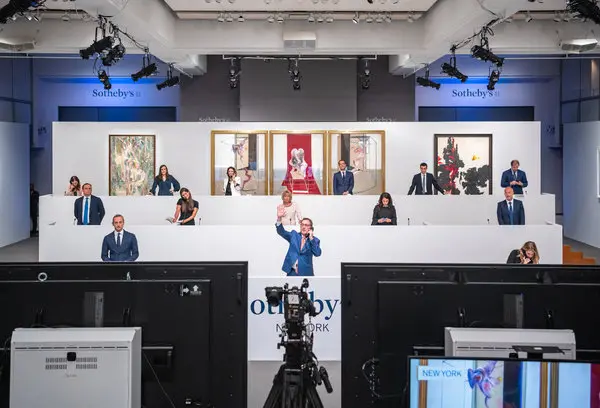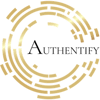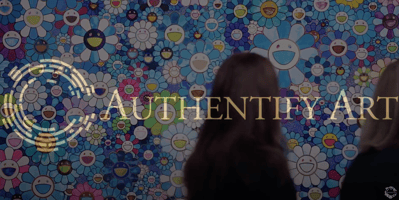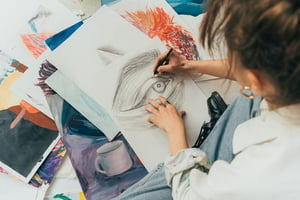Can an 18th century marketplace survive in the 21st century?

Reprinted from Linked In, 20 Sept 2023
Why auction houses need to embrace technology to build trust and scale the art market
History of Auction Houses
The practice of auction dates as far back as 500 BC in the Roman Empire. Unlike today the original auctions primarily include the spoils of war which included women and slaves. Yet the practice of sales in this style has evolved to make up our modern practices today. There are several styles of auctions, including English, Dutch, and Sealed-Bids. The most common is the English auction style, in which bidders start at a low price, and compete by offering higher prices until no-one will offer more, with the object going to the highest bidder. Dutch auctions start with a high bidding price, and incrementally decline until a buyer is found, while Sealed-Bids are anonymous, and the seller gets to choose the winner without disclosing the winning bid.
How has this once-barbaric method of selling humans evolved to play such a significant role in the art market making up more than a third of the $70 billion annual art industry?
Christie’s and Sotheby’s, the two largest auction houses in the world, were both established in the mid 1700s, but Sotheby’s claims the title for the oldest art auction house globally. Founded in 1744 by Samuel Baker, initial sales were focused on rare books and library collections. Sales have since evolved to include art and other historic artifacts. They now offer private, non-auction sales, which, with auction sales, accounts for about $8 billion in annual sales last year.
Similarly, Christie’s first sale was held in 1766 by founder James Christie in Pall Mall, London. In 1973, about 300 years and countless historic sales later, it transitioned to become a public company until 1998 when it went private again. Today, Christie’s holds 30% of annual sales in the total global art market, capturing $8.4 billion in 2022 sales.
While these two major auction houses account for more than half of all global art auction sales, some analysts are skeptical about the future of this traditional auction space due to scalability limitations of current processes.
Current State of the Industry
Growth of the global art market is relatively flat and experienced an uptick in sales of about 3%, annually. Today the market is valued at about $67.8 billion. So what is holding the industry back, why are these sales operations not scalable? At a high-level (at the risk of oversimplifying the process) auction houses source the artworks from their clients and then host a preview for pieces (some or all) that will go on sale for auction to entice potential buyers. Buyers register for the event, (more on the selection process later) and finally, when the auction begins, items are sold to the highest bidder.
Let’s take a step back and review the curation process for an auction, including both items to be sold and buyers that can participate. Before a piece can even be sold at auction, a variety of checkpoints are in place. The sellers themselves often have items independently appraised to determine an estimated value, but often, especially in the auction market, the offer value is determined by the auction house expert. Auction houses often find new undiscovered and hidden works that haven’t been seen before which can make appraisals and valuation difficult.That being said, determining authenticity is also critical and typically relies on reviewing documentation to determine the item’s provenance, to make sure that the item is what it claims to be. Art “authenticators” (connoisseurs) then provide the seller with an opinion about the attribution and quality of the work. Documents that can improve the value and can contribute to a precise attribute include are signed certificates of authenticity from the artist, appraisal documents, exhibition stickers, or other historic documents verifying identity. These documents are incredibly important when conducting valuation of any given work, as auction houses will conduct their own additional verification of documentation. Surprisingly, in this day and age, these documents are most often just physical pieces of paper, which poses not only a high risk of loss or damage but also are the most common source for fraud. Additionally, even if these documents are considered authentic they are separated from the painting they are tied to, so there is always a concern that the painting itself may be a copy or fake..
In addition to evaluating the art, auction houses also vet the buyers, they have strict requirements for who can attend and participate in the auction. More often than not, major auction houses require attendees to provide proof of funds in order to participate in the bidding process. This practice is rather invasive and thus often excludes all but the most determined ts certainly have alternatives to making a big purchase. Flea markets and estate sales, online auction marketplaces and large galleries have provided purchasers with the ability to participate from anywhere in the world.
Sites like Artsy and 1stdibs allow patrons to purchase pieces online, and each has its own unique value proposition. They both serve as an online marketplace for buyers and sellers alike, with pieces ranging in styles, and pricing ranging from hundreds to hundreds of thousands. Alternatively,art funds and more recently companies like Masterworks serve as a way to allow many investors to own part of a single piece. This fractionalization of art can serve as a more inclusive environment for both buyers and an alternative path to liquidity for sellers.
While these methods are useful in providing a more inclusive space for purchase, there are still some shortcomings to the existing infrastructure. Auction houses have been slow to adopt technology to fight fraud and better protect their customers. So while the pandemic has forced change and accelerated the adoption of online tools, very little progress has been made in improving and scaling the very manual process of curation and due diligence to ensure the authenticity of art and its supporting documentation. Because there is no direct connection between the art and its dossier, every time an artwork is offered for sale it must be completely re-evaluated since the chain of custody since the last sale has been broken.
How Auction Houses can Remain Competitive
To fix the problems of authenticity, chain of custody and attribution, tools such as RFID tagging and blockchain tokenization can transform the entirety of the art market. With both a physical tag and a securitized digital platform, any and all works of art can be identified at any given time. Especially in the secondary market where high value artworks reappear to be sold again years or decades after they were last purchased. To not have to perform complete and exhaustive due diligence every single time would be a game changer, saving money, saving time and allowing the process to scale. Even more experts could see the art and documents from anywhere in the world, increasing the pool of connoisseurs Matching expertise to an artist (as opposed to relying on generalists to make critical assessments) would radically improve evaluation of works.
In a future world where all works of art have secure ID’s (like VIN’s for art) and records are protected from corruption or fraud by blockchain ledgers , buyers will be able to verify a piece’s authenticity, condition and provenance with confidence from anywhere in the world. The broader implications to the art market of this use of modern technology is profound; for buyers, sellers, auction houses, and artists alike.
Building up participation in a stagnant secondary Art market.
With a larger and more liquid market, private owners will be incented to build a comprehensive dossier about their artwork prior to introducing them to the market. Not only will it protect the value of the assets, but also differentiate them from all other art in the market that has relied solely on the opinion of generalist connoisseurs. The long term impact of these technology improvements will be to increase trust, a development that will grow participation of new buyers and sellers. By using technology to add an additional layer of trust it is not unreasonable to predict that the art market could grow to three times its current size in the next decade. .
Conclusion
Auction houses must evolve or risk extinction. Although this multi-billion dollar industry deals with the sales of antiques and ancient artifacts, it doesn’t necessarily have to operate under the same arcane methodologies and limited technology of the 18th and 19th century.
With technology made specifically for fine art, digitally tracking and tracing pieces after sale, buyers can rest easy knowing that what they purchased is immutably connected to the entire dossier and history provided by the seller and auction house or dealer. Sellers in turn protect themselves from any future fraud that can have both reputational and financial costs. Furthermore, artists and their estates stand to benefit from royalties for future sales allowing them to participate in their success. Ultimately, auction houses can protect their reputations and leadership role in the art market by adopting technology to build a safer art market. Modernizing an antiquated industry won’t be easy, but with new technological innovations and advances in science, these are inevitable if the market is to grow.




